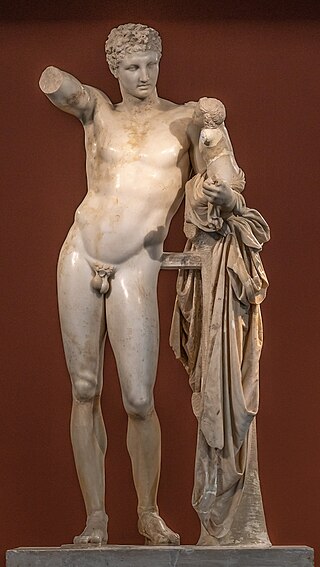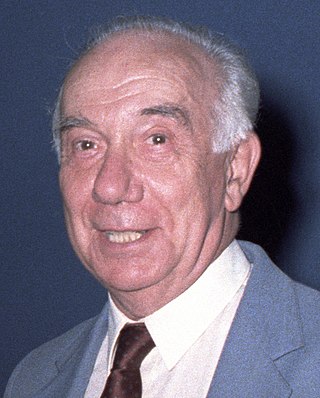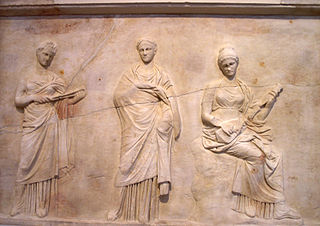Related Research Articles

The Louvre, or the Louvre Museum is a national art museum in Paris, France. A central landmark of the city, it is located on the Right Bank of the Seine in the city's 1st arrondissement and home to some of the most canonical works of Western art, including the Mona Lisa and the Venus de Milo. The museum is housed in the Louvre Palace, originally built in the late 12th to 13th century under Philip II. Remnants of the Medieval Louvre fortress are visible in the basement of the museum. Due to urban expansion, the fortress eventually lost its defensive function, and in 1546 Francis I converted it into the primary residence of the French Kings.

Praxiteles of Athens, the son of Cephisodotus the Elder, was the most renowned of the Attica sculptors of the 4th century BC. He was the first to sculpt the nude female form in a life-size statue. While no indubitably attributable sculpture by Praxiteles is extant, numerous copies of his works have survived; several authors, including Pliny the Elder, wrote of his works; and coins engraved with silhouettes of his various famous statuary types from the period still exist.

The Winged Victory of Samothrace, or the Nike of Samothrace, is a votive monument originally found on the island of Samothrace, north of the Aegean Sea. It is a masterpiece of Greek sculpture from the Hellenistic era, dating from the beginning of the 2nd century BC. It is composed of a statue representing the goddess Niké (Victory), whose head and arms are missing, and its base in the shape of a ship's bow.

Terracotta figurines are a mode of artistic and religious expression frequently found in ancient Greece. These figurines abound and provide an invaluable testimony to the everyday life and religion of the ancient Greeks. The so-called Tanagra figurines, in fact made elsewhere as well, are one of the most important types.
Edmond François Paul Pottier was an art historian and archaeologist who was instrumental in establishing the Corpus vasorum antiquorum. He was a pioneering scholar in the study of Ancient Greek pottery.
Michel Laclotte was a French art historian and museum director, specialising in 14th and 15th century Italian and French painting.

Hermes and the Infant Dionysus, also known as the Hermes of Praxiteles or the Hermes of Olympia is an ancient Greek sculpture of Hermes and the infant Dionysus discovered in 1877 in the ruins of the Temple of Hera, Olympia, in Greece. It is displayed at the Archaeological Museum of Olympia.
Christiane Ziegler, is a French Egyptologist, curator, director emeritus of the Department of Egyptian Antiquities of the Louvre Museum and editorial director of the archaeological mission from the Louvre Museum at Saqqara, Egypt.
Laurence Bertrand Dorléac is a French art historian specializing in contemporary art, a professor and an author. She was elected president of the Fondation nationale des sciences politiques in May 2021. She is located in Boulogne-Billancourt, France.

The Dancers of Delphi, also known as the Acanthus Column, are three figures in high relief on top of an acanthus column found near the sanctuary of Pythian Apollo at Delphi. They are on display in the Delphi Archaeological Museum and were the inspiration for the first of Claude Debussy's Préludes.
Jean-Luc Martinez is the former president of the Louvre. In May 2022 French police charged him with crimes including fraud and money laundering related to antiquities trafficking.

Léon-Maxime Collignon was a French archaeologist who specialized in ancient Greek art and architecture.
Jean Marie Augustin Charbonneaux was a 20th-century French archaeologist.

Jean Marcadé was a French hellenist historian. He was a member of the Institut de France.
Pierre Devambez was a 20th-century French Hellenist, archaeologist and historian of Greek art.
Étienne-Louis-Charles-Alexandre Michon was a French art historian.
Paul Frédéric Girard was a French Hellenist, archaeologist and epigrapher.
Michel Labrousse was a 20th-century French historian.

The Mantineia Base is an ensemble of three ancient Greek bas relief plaques, one of which depicts Apollo, Marsyas, and a slave, and the other two of which each show a group of three Muses. They were discovered in 1887 on the site of the ancient Gree city of Mantineia in Arcadia and were probably decoration for a statue base. They have been attributed to the sculptor Praxiteles or another member of his workshop. They are currently kept in the National Archaeological Museum of Athens, where their inventory numbers are NAMA 215–217.

Alain Erlande-Brandenburg was a French art historian and honorary general curator for heritage, a specialist on Gothic and Romanesque art.
References
- ↑ "Praxiteles". Louvre museum. Archived from the original on June 15, 2011. Retrieved June 14, 2010.